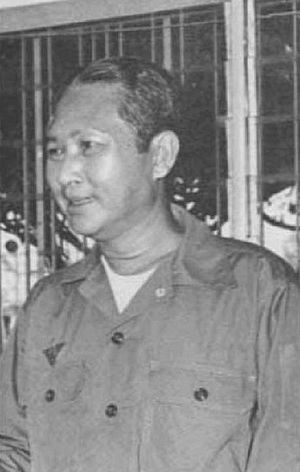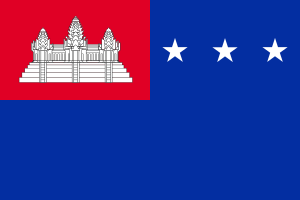Lon Nol facts for kids
Quick facts for kids
Lon Nol
|
|
|---|---|
| លន់ នល់ | |
 |
|
| President of the Khmer Republic | |
| In office 10 March 1972 – 1 October 1975 |
|
| Prime Minister | Sisowath Sirik Matak Son Ngoc Thanh Hang Thun Hak In Tam Long Boret |
| Preceded by | Cheng Heng |
| Succeeded by | Saukam Khoy (acting) |
| Prime Minister of the Khmer Republic | |
| In office 14 August 1969 – 20 April 1971 |
|
| President | Norodom Sihanouk Cheng Heng |
| Deputy | Sisowath Sirik Matak |
| Preceded by | Penn Nouth |
| Succeeded by | Sisowath Sirik Matak |
| In office 25 October 1966 – 1 May 1967 |
|
| President | Norodom Sihanouk |
| Preceded by | Norodom Kantol |
| Succeeded by | Son Sann |
| Minister of National Defence | |
| In office 7 June 1968 – 15 November 1971 |
|
| President | Cheng Heng Norodom Sihanouk |
| Prime Minister | Penn Nouth Himself Sisowath Sirik Matak |
| In office 10 September 1959 – 25 October 1966 |
|
| Monarch | Norodom Suramarit |
| President | Norodom Sihanouk |
| Prime Minister | Norodom Sihanouk Pho Proeung Penn Nouth Nhiek Tioulong (acting) Chau Sen Cocsal (acting) Norodom Kantol |
| Personal details | |
| Born | 13 November 1913 Kampong Leav District, Prey Veng Province, Cambodia, French Indochina |
| Died | November 17, 1985 (aged 72) St. Jude Medical Center Fullerton, California, U.S. |
| Political party |
|
| Parents |
|
| Signature |  |
| Military service | |
| Allegiance | |
| Branch/service | Royal Khmer Army Khmer National Army |
| Years of service | 1952–1975 |
| Rank | |
| Commands | Commander-in-Chief of the Khmer National Armed Forces |
| Battles/wars | First Indochina War |
Marshal Lon Nol (Khmer: លន់ នល់; 13 November 1913 – 17 November 1985) was a Cambodian politician and general. He served as Prime Minister of Cambodia two times. He also worked as a defence minister and a provincial governor.
Lon Nol was a nationalist and a conservative leader. In 1970, he led a military coup against Prince Norodom Sihanouk. After this, he ended the monarchy and created the Khmer Republic. This republic was officially a semi-presidential government. However, it was really run like a military dictatorship. Lon Nol was the commander of the Khmer National Armed Forces during the Cambodian Civil War. He left Cambodia on April 1, 1975, just before the Khmer Rouge took over Phnom Penh. He moved to the United States and lived there until he died in 1985.
Contents
Early Life and Education
Lon Nol was born on November 13, 1913, in Prey Veng Province, Cambodia. His family had both Khmer and Chinese roots. His father, Lon Hin, was known for stopping bandit groups. His mother's father was a Chinese immigrant who became a governor.
Lon Nol went to school at the Lycée Chasseloup-Laubat in Saigon. He also studied at the Cambodian Royal Military Academy.
Working for the Government
In 1937, Lon Nol started working for the French colonial government. He became a magistrate and was good at enforcing French rules. By 1946, he was the Governor of Kratie Province.
He became close with King Norodom Sihanouk. In the late 1940s, Lon Nol started a political group that wanted independence for Cambodia. He joined the army in 1952 and fought against the Viet Minh.
After Cambodia became independent, Lon Nol's party joined with other groups to form the Sangkum. This group was created by Sihanouk for the 1955 elections. Sangkum won, and Sihanouk became Prime Minister.
Serving Under Sihanouk (1955–1970)
Lon Nol became the Army Chief of Staff in 1955. By 1960, he was the commander-in-chief of the armed forces. He also served as Defence Minister. At this time, he was a trusted supporter of Sihanouk. His police helped to stop small communist groups in Cambodia.
In 1963, he became deputy Premier. Sihanouk tried to keep Cambodia neutral during the Vietnam War. This meant working with China and allowing North Vietnamese troops near Cambodia's borders. But Lon Nol remained friendly with the United States. He was sad when US aid to Cambodia stopped in 1963.
In the 1966 elections, Lon Nol and other conservative politicians gained more power. Lon Nol became Prime Minister. The next year, his troops stopped a revolt in Battambang Province.
Lon Nol was hurt in a car crash in 1967 and left politics for a while. But in 1968, he returned as Minister of Defence. In 1969, he became Prime Minister again. He chose Prince Sisowath Sirik Matak, who was against Sihanouk and supported the US, as his deputy.
The 1970 Coup
In March 1970, while Sihanouk was out of the country, there were protests against Vietnamese forces in Phnom Penh. On March 12, Lon Nol and Sirik Matak closed the port of Sihanoukville. This port was used to smuggle weapons to the Viet Cong. They told all North Vietnamese and Viet Cong forces to leave Cambodia within 72 hours.
At first, Lon Nol did not want to remove Sihanouk as the leader. But Sirik Matak played him a recording where Sihanouk blamed them for the unrest. Sihanouk also threatened to execute them when he returned. On March 17, Sirik Matak and army officers made Lon Nol sign the papers to remove Sihanouk.
On March 18, the National Assembly voted to remove Sihanouk from power. General Lon Nol took over as the Head of State. There were large protests supporting Sihanouk in some cities, but Lon Nol's forces stopped them. Hundreds of people died.
In October, the Khmer Republic was officially created. Sihanouk formed a government-in-exile with the Khmer Rouge communists. He was sentenced to death in Cambodia while he was away. In April 1970, US and South Vietnamese forces entered Cambodia to fight North Vietnamese and Viet Cong troops.
The Khmer Republic and Civil War
The Khmer Republic (1970–1975) changed Cambodia's neutral policies, especially towards Vietnam. This period was very difficult for Cambodia. Lon Nol's health got worse after he had a stroke in February 1971.
His rule became more strict. In April 1971, he made himself a Marshal, a new title in Cambodia. In October, he stopped the National Assembly from meeting. He said he would no longer "play the game of democracy and freedom" during wartime. Lon Nol also tried to control many of the Khmer National Armed Forces (FANK) operations himself.
Lon Nol's government relied heavily on aid from the United States. By 1975, his government controlled only Phnom Penh and the Preah Vihear Temple. The FANK was running out of ammunition. Lon Nol started to depend more on the advice of fortune tellers. For example, during a Khmer Rouge attack on Phnom Penh, he sprinkled special sand to protect the city.
Finally, on April 1, 1975, Lon Nol resigned and left Cambodia. His name was on a list of people the Khmer Rouge wanted to execute.
Exile and Death
After the Khmer Rouge took over Cambodia, they executed many former leaders. Lon Nol was able to escape. He went to Indonesia first, then to the United States. He lived in Hawaii and Michigan before settling in Fullerton, California, in 1979.
He lived with his second wife, Sovanna Lon, and some of his nine children. Lon Nol died on November 17, 1985, at St. Jude Medical Center from a heart condition.
Political Ideas
Lon Nol believed in traditional Cambodian ways, even after removing Sihanouk. He once bowed to the Queen Mother to ask for forgiveness. He called his ideas "Neo-Khmerism." This was a mix of strong nationalism and spiritual beliefs.
He wanted to unite all ethnic Khmers, including those in the Mekong Delta and Thailand. He dreamed of a "thirty million" Khmer state by 2020. He encouraged his followers to be like "holy warriors" and called himself their "Black Papa." This name referred to dark skin, which was seen as a sign of a true Khmer. Later in life, Lon Nol said he was a "black Khmer" and tried to hide his partial Chinese background.
Family Life
Lon Nol had two younger brothers. His brother, Lon Nil, was killed by people who supported Sihanouk in 1970. Another brother, Lon Non, worked as a Minister and Ambassador for the Khmer Republic. The Khmer Rouge executed him after the Fall of Phnom Penh.
Lon Nol's grandnephew is the French kickboxer Antoine Pinto. Lon Nol's son, Lon Rith, started the Khmer Republican Party in 2006.
See also
 In Spanish: Lon Nol para niños
In Spanish: Lon Nol para niños
- Lon Nil
- Lon Non


